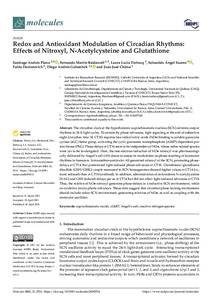Por favor, use este identificador para citar o enlazar este ítem:
https://repositorio.uca.edu.ar/handle/123456789/11523| Título: | Redox and antioxidant modulation of circadian rhythms : Effects of nitroxyl, N-acetylcysteine and glutathione | Autor: | Plano, Santiago Andrés Baidanoff, Fernando Martín Trebucq, Laura Lucía Suárez, Sebastián Ángel Doctorovich, Fabio Golombek, Diego A. Chiesa, Juan José |
Palabras clave: | SISTEMA NERVIOSO CENTRAL; OXIDO NITRICO; NUCLEO SUPRAQUIASMATICO; MONOFOSFATO DE GUANOSINA CÍCLICO | Fecha de publicación: | 2021 | Editorial: | Multidisciplinary Digital Publishing Institute | Cita: | Plano, S. A., Baidanoff, F. M., Trebucq, L.L., Suarez, S.Á., Doctorovich, F., Golombek, D.A., Chiesa, J.J. Redox and antioxidant modulation of circadian rhythms : Effects of nitroxyl, N-acetylcysteine and glutathione [en línea]. Molecules 2021, 26(2514). Doi: 10.3390/ molecules26092514. Disponible en: https://repositorio.uca.edu.ar/handle/123456789/11523 | Resumen: | Abstract: The circadian clock at the hypothalamic suprachiasmatic nucleus (SCN) entrains output rhythms to 24-h light cycles. To entrain by phase-advances, light signaling at the end of subjective night (circadian time 18, CT18) requires free radical nitric oxide (NO ) binding to soluble guanylate cyclase (sGC) heme group, activating the cyclic guanosine monophosphate (cGMP)-dependent protein kinase (PKG). Phase-delays at CT14 seem to be independent of NO , whose redox-related species were yet to be investigated. Here, the one-electron reduction of NO nitroxyl was pharmacologically delivered by Angeli’s salt (AS) donor to assess its modulation on phase-resetting of locomotor rhythms in hamsters. Intracerebroventricular AS generated nitroxyl at the SCN, promoting phasedelays at CT14, but potentiated light-induced phase-advances at CT18. Glutathione/glutathione disulfide (GSH/GSSG) couple measured in SCN homogenates showed higher values at CT14 (i.e., more reduced) than at CT18 (oxidized). In addition, administration of antioxidants N-acetylcysteine (NAC) and GSH induced delays per se at CT14 but did not affect light-induced advances at CT18. Thus, the relative of NO nitroxyl generates phase-delays in a reductive SCN environment, while an oxidative favors photic-advances. These data suggest that circadian phase-locking mechanisms should include redox SCN environment, generating relatives of NO , as well as coupling with the molecular oscillator. | URI: | https://repositorio.uca.edu.ar/handle/123456789/11523 | ISSN: | 1420-3049 | Disciplina: | MEDICINA | DOI: | 10.3390/ molecules26092514 | Derechos: | Acceso abierto | Fuente: | Molecules 2021, 26(2514) |
| Aparece en las colecciones: | Artículos |
Ficheros en este ítem:
| Fichero | Descripción | Tamaño | Formato | |
|---|---|---|---|---|
| redox-antioxidant-modulation-circadian.pdf | 1,68 MB | Adobe PDF |  Visualizar/Abrir |
Visualizaciones de página(s)
80
comprobado en 27-abr-2024
Descarga(s)
95
comprobado en 27-abr-2024
Google ScholarTM
Ver en Google Scholar
Altmetric
Altmetric
Este ítem está sujeto a una Licencia Creative Commons

